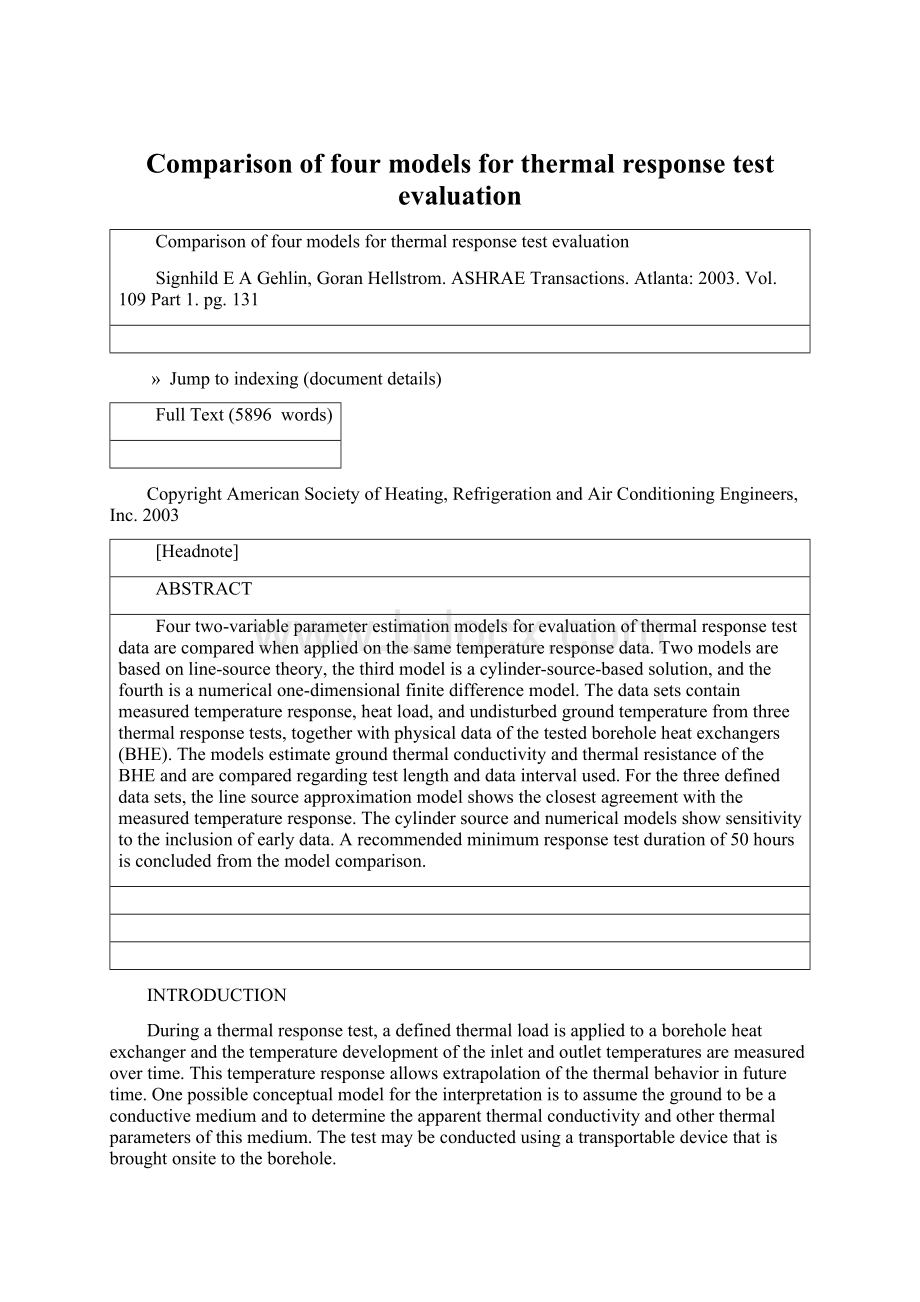Comparison of four models for thermal response test evaluation.docx
《Comparison of four models for thermal response test evaluation.docx》由会员分享,可在线阅读,更多相关《Comparison of four models for thermal response test evaluation.docx(19页珍藏版)》请在冰豆网上搜索。

Comparisonoffourmodelsforthermalresponsetestevaluation
Comparisonoffourmodelsforthermalresponsetestevaluation
SignhildEAGehlin,GoranHellstrom.ASHRAETransactions.Atlanta:
2003.Vol.109Part1.pg.131
» Jumptoindexing(documentdetails)
FullText (5896 words)
CopyrightAmericanSocietyofHeating,RefrigerationandAirConditioningEngineers,Inc.2003
[Headnote]
ABSTRACT
Fourtwo-variableparameterestimationmodelsforevaluationofthermalresponsetestdataarecomparedwhenappliedonthesametemperatureresponsedata.Twomodelsarebasedonline-sourcetheory,thethirdmodelisacylinder-source-basedsolution,andthefourthisanumericalone-dimensionalfinitedifferencemodel.Thedatasetscontainmeasuredtemperatureresponse,heatload,andundisturbedgroundtemperaturefromthreethermalresponsetests,togetherwithphysicaldataofthetestedboreholeheatexchangers(BHE).ThemodelsestimategroundthermalconductivityandthermalresistanceoftheBHEandarecomparedregardingtestlengthanddataintervalused.Forthethreedefineddatasets,thelinesourceapproximationmodelshowstheclosestagreementwiththemeasuredtemperatureresponse.Thecylindersourceandnumericalmodelsshowsensitivitytotheinclusionofearlydata.Arecommendedminimumresponsetestdurationof50hoursisconcludedfromthemodelcomparison.
INTRODUCTION
Duringathermalresponsetest,adefinedthermalloadisappliedtoaboreholeheatexchangerandthetemperaturedevelopmentoftheinletandoutlettemperaturesaremeasuredovertime.Thistemperatureresponseallowsextrapolationofthethermalbehaviorinfuturetime.Onepossibleconceptualmodelfortheinterpretationistoassumethegroundtobeaconductivemediumandtodeterminetheapparentthermalconductivityandotherthermalparametersofthismedium.Thetestmaybeconductedusingatransportabledevicethatisbroughtonsitetotheborehole.
Sinceitsintroductionin1995-1996,thisin-situmethodhasspreadtomostcountrieswhereboreholesinthegroundareusedasaheatsource/sinkonalargerscale.Themethodservesprimarilytoassessthegroundthermalconductivityandperformanceofdifferentboreholeheatexchangerdesigns,whichareimportantforoptimaldesignandqualitycontrol.Themethodisdescribedinseveralpapers,e.g.,Gehlin(1998),Austin(1998),Austinetal.(2000),ShonderandBeck(2000),andKavanaughetal.(2000).TheprincipleofathermalresponsetestsetupisoutlinedinFigure1.
Theboreholetemperatureresponseisthetemperaturedevelopmentovertimeoftheheatcarrierfluidcirculatingthroughtheboreholeheatexchangerwhenaknownheatingorcoolingloadisimposed.Byevaluatingtheincreasingfluidtemperatureversustime,informationaboutthethermalpropertiesinandaroundtheboreholeisobtained.Alowthermalconductivityis,e.g.,indicatedbyamorerapidtemperatureresponse.Theresponsealsogivesinformationaboutthetemperaturedifferencebetweentheheatcarrierfluidandthesurroundinggroundcausedbytheheattransfer,i.e.,thethermalresistanceoftheboreholeheatexchanger.
Enlarge200%
Enlarge400%
Figure1Thermalresponsetestsetup.
Severalanalyticalandnumericalmethodsareusedfortheevaluationofresponsetesttemperaturedata.Thedifferentmodelsrequiresomewhatdifferentsetsofinputdata.Variousanalyticalmethodsforevaluationofboreholeresponsetestdataarediscussedbelow.
EvaluationMethods
Anumberofmethodshavebeenappliedovertheyearsforthesimulationofboreholeheatexchangerperformance.Bothanalyticalandnumericalmodelshavebeenusedandreportedinseveralpapers,reports,andbooks.Here,thefocusisonmodelsfortheevaluationofthermalresponsetestdatafordetermininggroundthermalconductivityandevaluationoftheefficiencyoftheboreholeheatexchanger.
Thethermalresponsetestmethodisbasedontheso-calledsingleprobemethodfordeterminingthethermalconductivityofsolidmaterialsinalaboratoryenvironment(StalhaneandPyk1931).Initialanalyseswerebasedontheline-sourceapproximation,whichdoesnotconsiderthethermalpropertiesoftheprobematerial.In1954,Blackwellpresentedananalyticalsolutionincludingboththeprobematerialandapossiblecontactresistanceattheprobesurface.Inprinciple,thismethodmakesitpossibletoshortenthemeasurementperiods,especiallyforlargeprobediameters.Attemptstodetermineboththermalconductivityanddiffusivitysimultaneouslybytakingthecontactresistanceintoaccountwerenotsuccessful(Blackwell1954;Becketal.1956).Thedeterminationofthethermaldiffusivitywasfoundtobeverysensitivetothecontactresistance.Sundberg(1988)developedadetailedFEMmodeloftheprobeinordertoshortenthemeasurementperiod.Hefoundthatboththermalconductivityanddiffusivitywereheavilyinfluencedduringtheinitialtimeperiodbysmallchangesintheprobeproperties.
Analyticalmodels,suchastheline-sourceandcylinder-sourcetheories,requireseveralsimplifyingassumptionsregardingthegeometryoftheboreholeandheatexchangerpipes.Forthepurposeofthethermalresponsetestevaluation,theheatflowtoorfromtheboreholemayberepresentedasaninfinitelylongheatsourceorsinkinthegroundwithnegligibleinfluenceofheatflowsinadirectionalongtheboreholeaxis.Inthegroundoutsidetheboreholeitiscommonpracticetoassumethatthethermalprocessdependsonlyontheradialdistancefromtheboreholeaxis.Theone-ortwo-dimensionalheatflowprocessfromthecirculatingfluidtotheboreholewallisassumedtoberepresentedbyathermalresistancethatcharacterizesthetemperaturelossbetweenheatcarrierfluidandboreholewall.Somemodelsalsoincludethethermalmassofthematerialsintheborehole.
IngersollandPlass(1948)appliedtheline-sourcemodeltothedesignofgroundloopheatexchangers.Mogensen(1983)proposedtouseaboreholesimilartotheprobetoestimatethegroundthermalconductivityfromanexperimentalfieldtest.ThismethodisnowcommonlyusedforthermalresponsetestevaluationinEurope.
ThecylindersourceapproachmodelsthegroundloopheatexchangerasacylinderbyintroducinganequivalentdiametertorepresentthetwopipesofasingleU-pipeheatexchangerasasinglecoaxialpipe.CarslawandJaeger(1959)developedanalyticalsolutionswithvaryingboundaryconditionsforregionsboundedbycylindergeometry.DeermanandKavanaugh(1991)andKavanaughandRafferty(1997)describetheuseofthecylinder-sourcemodelindesigninggroundloopheatexchangers.Theeffectivethermalconductivity(anddiffusivity)ofthegroundformationiscomputedbyreversingtheprocessusedtocalculatethelengthofthegroundloopheatexchanger.Basedonashort-termin-situtest,themeasuredeffectivethermalresistanceofthegroundofadailyheatpulseisfittedtoavaluecomputedfromadimensionlesscylinder-sourcefunctionbyvaryingthethermalconductivityanddiffusivityoftheground.
Numericalmodelscanbedesignedtohandledetailedrepresentationsoftheboreholegeometryandthermalpropertiesofthefluid,pipe,boreholefilling,andground,aswellasvaryingheattransferrates.Themoreextensivesetofrequiredinputdataoftenmakethesemodelsmoredifficultandtime-consumingtousethantheanalyticalmethods,whichsometimesmaybeimplementedassimplespreadsheetapplications.
Berberichetal.(1994)describearesponsetesttypeofmeasurementingroundwater-filledductsinwater-saturatedclaystonewheretemperaturesensorswereplacedalongtheboreholewall.Themeasureddatawereanalyzedwithbothananalyticalline-sourcemodelandanumericaltwo-dimensionalfinitedifferencemodelusingparameterestimationwithgroundthermalconductivityandvolumetricheatcapacityasvariables.Thenumericalmodelcalculatestheheatflowsinboththeverticalandtheradialdirectionsforaboreholeoffinitelength.Theresultsfromthenumericalanalysesresultedin5%lowerthermalconductivityvaluesthantheanalyticalresults.Berberichetal.(1994)attributethisdifferencetoendeffectsofthefinite-lengthborehole,i.e.,increasedheattransfernearthetopandbottomoftheborehole.
ShonderandBeck(1999)developedaparameter-estimation-basedmethod,whichisusedincombinationwithaone-dimensionalnumericalmodel.Thismodelissimilartoacylinder-sourcerepresentationinthatitrepresentsthetwopipesoftheU-tubeasasinglecylinder.However,itaddstwomorefeatures-athinfilmthataddsaresistancewithoutheatcapacityandalayerofgrout,whichmayhaveathermalconductivityandheatcapacitydifferentfromthesurroundingsoil.Thismodelaccommodatestime-varyingheatinput.
Atransienttwo-dimensionalnumericalfinitevolumemodelinpolarcoordinatesforresponsetestevaluationisreportedinAustin(1998)andAustinetal.(2000).ThegeometryofthecircularU-tubepipesisapproximatedby"pie-sectors,"overwhichaconstantfluxisassumed.TheconvectionresistanceduetotheheattransferfluidflowinsidetheU-tubesisaccountedforbyusingfluidpropertiesthroughanadjustmentontheconductivityofthepipewallmaterial.AthoroughdescriptionofthenumericalmodelisfoundinYavuzturketal.(1999).Themodelhassincebeenimprovedbyintroducingaboundary-fittedgridsystemthatismoreflexibleandbetterrepresentstheU-tubepipegeometry(Spitleretal.2000).Themodeliscomparedwiththeline-sourceandcylinder-sourcemodelsinAustin(1998).
Enlarge200%
Enlarge400%
TABLE1
SummaryofRequiredInputtotheFourAnalysisModels
Smith(1999)